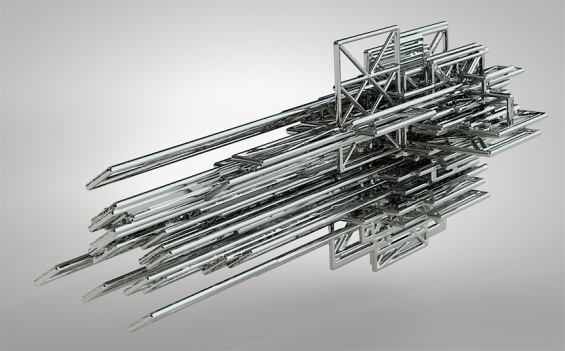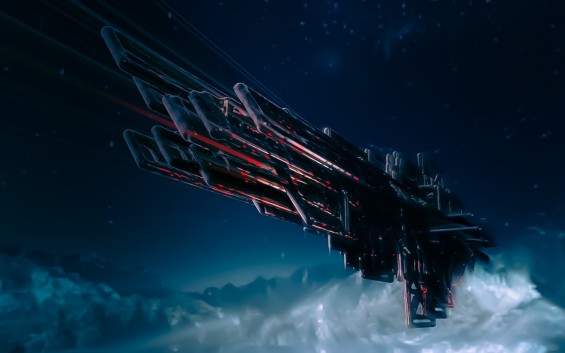



StarshipSPIDER
Text written by Dr. Rachel Armstrong (UK) in conversation with Frederik De Wilde.
StarshipSPIDER was presented at TEDx_Cern 2015 during Dr. Armstrong’s presentation.
Intro
Frederik De Wilde’s starshipSPIDER is a concept craft that is inspired by the architectons of Kazimir Malevich (MOMA, 2013). At the turn of the 1920’s Malevich started applying the Supremacist theories that he had previously developed in painting to architectonic forms as projections of his cosmic dreams of the Planits, which were the animated equivalent of the floating cities with the names of Greek letters that Malevich called Architectons. These utopian, spaceship-like vehicles were set out in great detail that did not pertain to any specific scale. Yet, Malevich rejected utilitarianism and did not insist that his models should be made. His ambitions were absolute and free of context, which perhaps embodied a desire to escape the history of the Soviet Union and its spectre of ‘’human misfortune.’’
StarshipSPIDER
Yet, De Wilde’s starshipSPIDER is more than an inert hull moving through interstellar space. It is a body that talks about the construction of interstellar space, its Spartan ecology and the strangeness of matter. It’s absolute blackness links matter with the abyss. It spins its own scaffolding that it uses as a locomotory system to infiltrate unknown territories. As it’s multiple, intersecting carbon planes voyage through the ‘ emptiness of space, it weaves threads formed by photonic winds and buckyballs. Tirelessly constructing cosmic theatres between galaxies the starshipSPIDER’s web snares epic vagrant celestial bodies that invent narratives and strange events as they shake and struggle in its dark cosmic web. Vibrations from these performances resonate throughout the universe fusing with primal notes from its background noise.
StarshipSPIDER is pitilessly black. Its artistic roots arising deep within the satanic mills of the industrial revolution that spewed black carbon into Earth’s atmosphere and marked the urban environment with its dark scars as an absolute rejection of the depiction of objects in favor of pure expression, evoking moods that ranged from joy to chaos (Peplow, 2015).
In an interstellar context StarshipSPIDER yearns for kinship with both the visible and dark universes generating scaffoldings that communicate between these incompatible realms and in doing so synthesizes an unlikely, restless space ecology.
The concepts underpinning StarshipSPIDER are a very long way from being buildable however; the elegance of the project emphasizes the idea of space as an inhabited ecology in which a range of epic nonhuman inhabitants dwells. It conceives the very purpose of the interstellar craft not just as a transport hull but a discovery vehicle with a metabolism that makes and shapes space as it passes through it. Splitting and repairing the very fabric of the cosmos, the trails of our vessels therefore produce highways for successive craft and develop sites of significance along the way. It is an attractor of material organization and a catalyst for life, as we have not yet encountered it.
StarshipSPIDER reminds us of the primitive status of our own legacy of space exploration with our clumsy, industrial hulls and trails of pollution and asks us to think again about our future relationship with the fabric of space and the assumption that it is not alive.
How StarshipSPIDER actually influences spaceship design – is as yet unknown. But to fully grasp what is at stake, let’s turn its conceptual design back on our cars, our ships, and our planes. What might happen if our vehicles today actually repaired rather than destroyed environmental relationships and created opportunities for ecodiversity rather than an indelible legacy of biospherical scars?
◊
Ed. 1. / 7 . AP
◊
The sculptures can be produced in different materials and sizes, e.g. copper, nickel, chrome, silver and gold (non-exhaustive list). Each material is de facto a limited edition.
